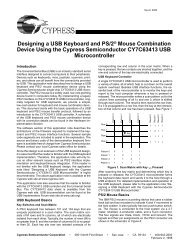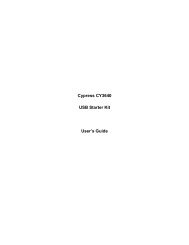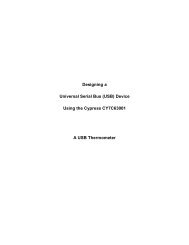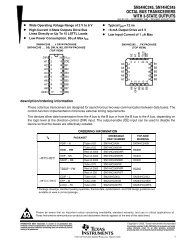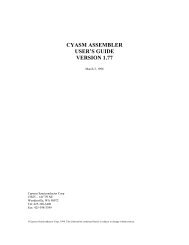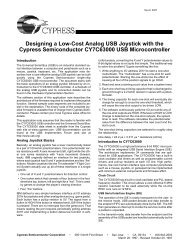Designing a USB Keyboard with the Cypress Semiconductor ...
Designing a USB Keyboard with the Cypress Semiconductor ...
Designing a USB Keyboard with the Cypress Semiconductor ...
- No tags were found...
You also want an ePaper? Increase the reach of your titles
YUMPU automatically turns print PDFs into web optimized ePapers that Google loves.
<strong>Designing</strong> a <strong>USB</strong> <strong>Keyboard</strong>Figure 15. Endpoint 1 Interrupt Service RoutineByte 7 - Key 6Byte 6 - Key 5Byte 5 - Key 4Byte 4 - Key 3Byte 3 - Key 2Byte 2 - Key 1Byte 1 - ReservedBit 7 Bit 0RightGUIEnd Point 1RightAltReceivedACK fromlast TxYesRightShiftRightCtrlNoClear End Point 1 FIFOToggle Data PIDLeftGUILeftAltLeftShiftReturnLeftCtrlByte 0-ModifierFigure 16. IN Data Organization for <strong>USB</strong> <strong>Keyboard</strong>Bit 7 Bit 0ConstantConstantConstantKana ComposeScrollLockCapsLockNumLockByte 0-LED reportFigure 17. LED Report for <strong>USB</strong> <strong>Keyboard</strong>The byte order and bit field positions are defined by <strong>the</strong> HIDreport descriptor (discussed below), and are also consistent<strong>with</strong> <strong>the</strong> Boot Protocol requirements for legacy systems.<strong>USB</strong> DescriptorsAs stated earlier, <strong>the</strong> <strong>USB</strong> descriptors hold information about<strong>the</strong> device. There are several types of descriptors, which willbe discussed in detail below. All descriptors have certaincharacteristics in common. Byte 0 is always <strong>the</strong> descriptorlength in bytes and Byte 1 is always <strong>the</strong> descriptor type. Discussionof <strong>the</strong>se two bytes will be omitted from <strong>the</strong> followingdescriptions. The rest of <strong>the</strong> descriptor structure is dependenton <strong>the</strong> descriptor type. An example of each descriptor will begiven. Descriptor types are device, configuration, interface,endpoint, string, report, and several different class descriptors.Device DescriptorThis is <strong>the</strong> first descriptor <strong>the</strong> host requests from <strong>the</strong> device.It contains important information about <strong>the</strong> device. The sizeof this descriptor is 18 bytes. A list follows:• <strong>USB</strong> Specification release number in binary-coded decimal(BCD) (2 bytes)• Device class (1 byte)• Device subclass (1 byte)• Device protocol (1 byte)• Max packet size for Endpoint 0 (1 byte)• Vendor ID (2 bytes)• Product ID (2 bytes)• Device release number in BCD (2 bytes)• Index of string describing Manufacturer (Optional) (1 byte)• Index of string describing Product (Optional) (1 byte)• Index of string containing serial number (Optional) (1 byte)• Number of configurations for <strong>the</strong> device (1 byte)Example of a device descriptorDescriptor Length (18 bytes)Descriptor Type (Device)Complies to <strong>USB</strong> Spec Release (1.00)Class Code (insert code)Subclass Code (0)Protocol (No specific protocol)Max Packet Size for endpt 0 (8 bytes)Vendor ID (<strong>Cypress</strong>)Product ID (<strong>USB</strong> <strong>Keyboard</strong>)Device Release Number (1.03)String Describing Vendor (None)String Describing Product (None)String for Serial Number (None)Possible Configurations (1)7



